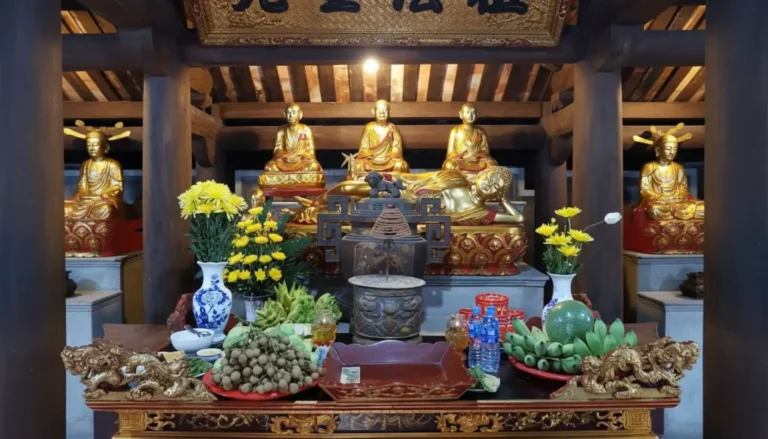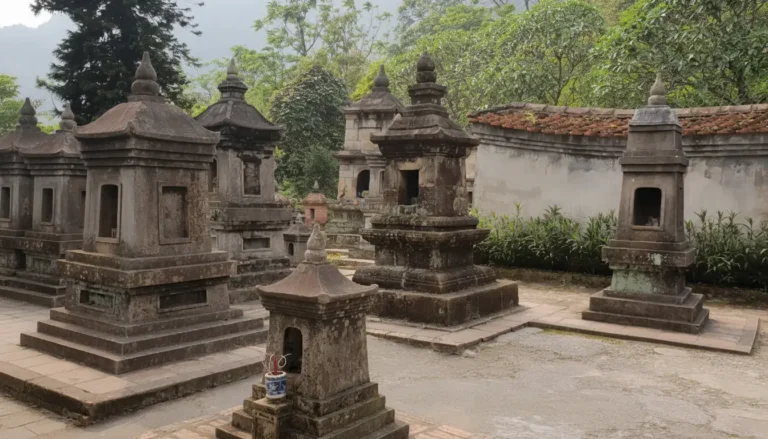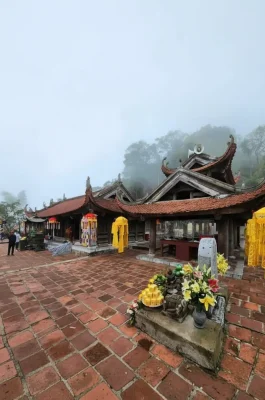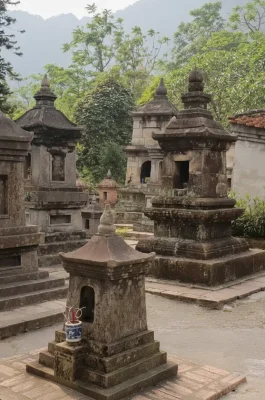Hoa Yen Pagoda: Where Trúc Lâm Zen Took Root
Hoa Yen Pagoda (Chùa Hoa Yên), originally named Vân Yên (Cloud Yên), serves as the central and most historically significant pagoda in the entire Yên Tử Mountain complex in Quảng Ninh Province. Perched at an elevation of approximately 534 meters above sea level, this revered site offers pilgrims and travelers a vital pause on their journey to the summit. The pagoda combines spiritual tranquility with deep historical layers, making it an unmissable destination.
History and Spiritual Significance
Hoa Yen Pagoda boasts a history dating back to the Lý Dynasty (11th century). It truly flourished, however, under the Trần Dynasty, becoming the principal center for the Trúc Lâm Zen Buddhism sect.
Birthplace of a Sect: Buddhist Emperor Trần Nhân Tông (1258–1308) chose the area around this pagoda as his primary place of practice after abdicating his throne. He founded the Trúc Lâm Zen lineage here. Consequently, Hoa Yen became the main venue where the Emperor-Monk and his successors, Pháp Loa and Huyền Quang, taught the foundational principles of Vietnamese Zen.
The Name Change: Originally, the pagoda carried the name Vân Yên (Cloud Yên), reflecting its high location often shrouded in mist. The name was later changed to Hoa Yên (Flower Yên) by King Lê Thánh Tông in the 15th century, who felt the area’s beautiful, blooming landscape inspired the new name.
Ancient Trees: The courtyard features two ancient Đại trees (Plumeria/Frangipani) believed to be over 700 years old. These towering trees stand as silent witnesses to the pagoda’s enduring spiritual heritage.

Architecture and Cultural Experience
The pagoda showcases a traditional architectural style, though it has undergone multiple reconstructions over the centuries due to wear and tear. It is not a massive structure but maintains a solemn, expansive feel due to the large courtyard and surrounding forest.
Central Worship: Visitors primarily worship the Buddha and the Tam Tổ Trúc Lâm (Three Founders of the Trúc Lâm Zen Sect) here. Therefore, you will find a serene and respectful atmosphere, ideal for quiet contemplation.
Stupas and Towers: The site includes the Huệ Quang Stupa, which houses the relics of the First Patriarch, Trần Nhân Tông, and the Thiền Định Tower. Exploring these structures reveals the depth of the complex’s history.

Access and Visitor Logistics
Hoa Yen Pagoda sits on the first plateau of the mountain pilgrimage route, making it easily accessible.
Via Cable Car: The first cable car route (Hoàng Long) from the base (Suối Giải Oan – Giai Oan Stream) carries visitors directly to the area near Hoa Yen Pagoda. This option offers a swift and scenic ascent.
Via Hiking Trail: Hikers typically reach Hoa Yen after about 1 to 2 hours of climbing from the base. This stretch, while steep, prepares pilgrims for the more challenging ascent to Chùa Đồng at the very peak.
| Item | Details and Access | Visitor Tip |
|---|---|---|
| Location | Mid-mountain on Yên Tử, accessible via the first cable car route. | You should wear comfortable, modest clothing as an act of respect. |
| Entrance Fee | You pay a general entrance fee to the Yên Tử complex at the base (approx. VND 40,000 per adult). No separate fee for the pagoda itself. | Be sure you carry small denominations of Vietnamese Dong for offerings. |
| Cable Car Access | Route 1 (Hoàng Long): From Giai Oan Pagoda to Hoa Yen Pagoda area. | Take advantage of the stunning views during the ride. |
| Operating Hours | Generally 6:00 AM – 6:00 PM daily. | The best time to visit is during the autumn (September to November) for cooler weather and fewer crowds than the spring festival. |
| Address | 5P29+J2C, Thượng Yên Công, Uông Bí, Quảng Ninh, Vietnam | This location confirms the central mid-mountain position. |
In conclusion, Hoa Yen Pagoda provides a perfect spot to appreciate the spiritual legacy of Yên Tử before continuing your pilgrimage to the mountain peak.









